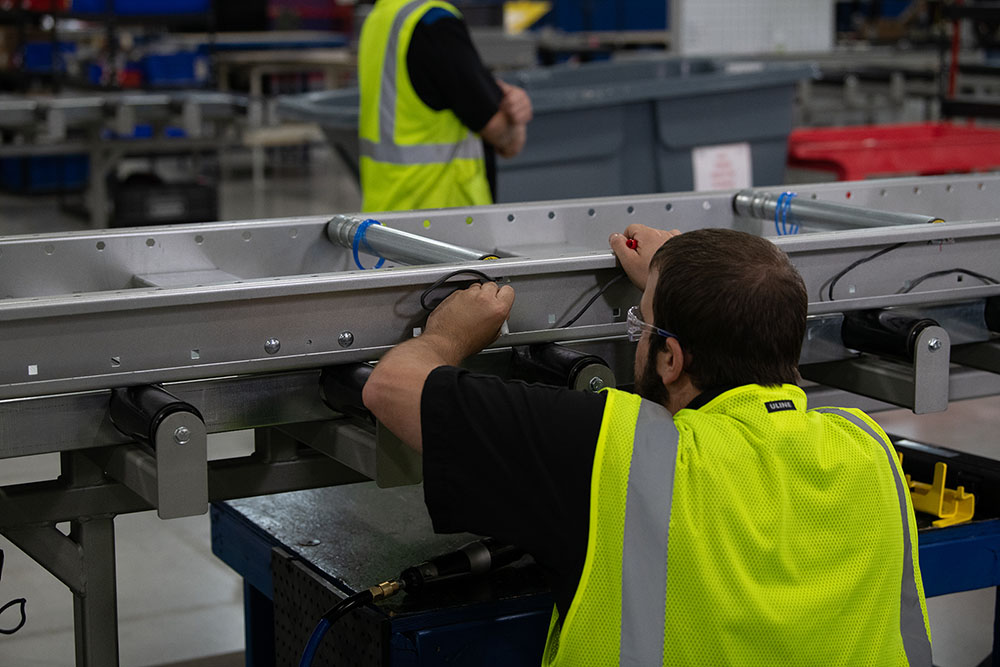
4 Types of DC Automation Maintenance for Less Operation Downtime
Joe Phillips | 2 June 2021
If you look up the word maintenance on the internet, you will find a lot of different variations in definition – from how often to service equipment to what degree of maintenance – and terminology. The bottom line is that the need of a maintenance plan cannot be ignored.
The most common types of maintenance in the material handling industry can be put into four distinct categories: reactive, preventive, predictive or reliability-centered. No matter if you have just a small conveyor system or a multimillion dollar fully automated distribution center you will have to perform maintenance activities to keep the equipment running. For each method, there are pros and cons.
The question I normally ask a client when we discuss maintenance is – “What is your tolerance for pain?” This boils down to how long can your equipment be down and out of use without costing you significant amounts of money because you cannot fulfill your customers’ orders. That threshold is important to understand and define so you can take the appropriate level of precautions.
Industry statistics show that revenue loss is real and significant. More than $50 billion is lost annually due to unplanned downtime and that unplanned downtime is estimated at 10 times the cost of planned downtime.
1. Reactive Maintenance
Reactive maintenance is the practice of running a piece of equipment until it fails. No maintenance activities are preformed until a failure occurs and then it is fixed. It is estimated that more that 55% of customers preform their maintenance activities in this mode.
While this may seem like a way to save money on labor it normally winds up costing substantially more. Reactive maintenance costs three to nine times more than preventive maintenance because of additional impacts like secondary damage to the equipment, lost production, rush shipping, and employee overtime.
A reactive approach can also shorten the lifespan of the equipment by up to 60%. From a safety perspective, technicians are 28% more likely to have an accident when the work is reactive because they are under intense pressure to get the equipment back up and running. During these scenarios they tend to take risks or shortcuts that they would not otherwise take with a proper plan to complete the work safely.
2. Preventive Maintenance
Preventative maintenance is the practice of preforming manufacturer’s recommended maintenance functions like cleaning, lubrication, adjustments, and minor repairs on a regularly scheduled timeframe.
These scheduled activities allow the technicians to routinely monitor the equipment and to identify parts that are not preforming well and may need to be replaced and this can be accomplished during scheduled downtime. This approach is estimated to have a 12% to 18% cost savings over reactive maintenance and increases the equipment life cycle.
According to a 2017 survey by Plant Engineering, organizations that used preventive maintenance saw a 69% decrease in equipment downtime and 66% of organizations reduced the probability of failure and extended the operational lifetime of the assets.
3. Predictive Maintenance
Predictive maintenance is the practice that uses condition-monitoring tools to track the performance of equipment during operation to detect possible defects. Predictive maintenance bases maintenance activity on the actual condition of the equipment instead of a preset schedule.
This type of maintenance program can reduce downtime by 80% and increase uptime and availability of equipment by 10% to 20% versus the reactive maintenance model. The downside to the predictive maintenance model is the significant start-up cost for staff training and monitoring equipment.
4. Reliability Centered Maintenance
Reliability centered maintenance is the practice of developing a specific maintenance strategy for each piece of equipment in the facility. This type of maintenance program will most likely have a combination of maintenance approaches to maintain the equipment. Since all equipment is not of the same importance to a facility it provides a systemic approach to best match the equipment and labor to structure a cost- effective maintenance program.
This type of program melds together a combination of maintenance approaches:
- Usually, less than 10% reactive
- 25% to 35% preventive
- 45% to 55% predictive
As with predictive maintenance the start-up cost for the training and monitoring equipment is a significant investment. However, factoring in downtime mitigated costs, it remains the most efficient maintenance program.
Get Ahead of Downtime
There isn’t one right answer when it comes to building a maintenance strategy. Like automation systems, the appropriate solution varies per scenario. The bottom line is that building a comprehensive maintenance plan, of any kind, for your automated equipment is critical to achieve the maximum uptime of your system. Having no plan in place is costly and chaotic, defaulting to a reactive maintenance approach.
Bastian Solutions can help you create a maintenance model that fits your business needs. As a Toyota Advanced Logistics company, Bastian Solutions can provide preventative maintenance and 24/7 emergency support services utilizing skilled technicians across our Toyota and Raymond dealer partners.
Joe is the Integrated Systems Maintenance Manager for Bastian Solutions and has over twenty-seven years in systems conceptualization, design analysis, material handling systems specification, proposal development, project and program management, design engineering, project implementation and customer service operations. Joe holds an associate degree in Industrial Engineering from the State Technical Institute at Memphis and is a licensed general contractor in the state of Georgia since 2009.
Comments
No comments have been posted to this Blog Post
Leave a Reply
Your email address will not be published.
Comment
Thank you for your comment.